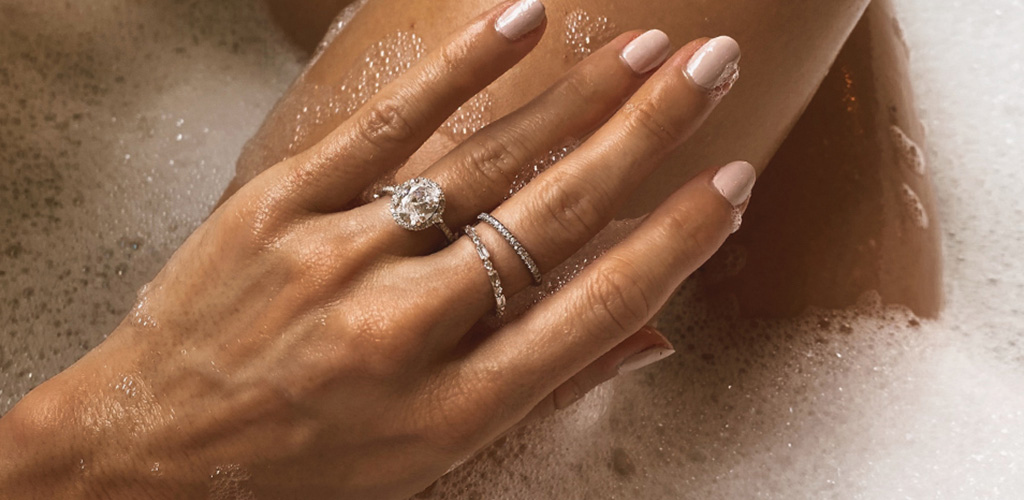
Fine jewelry, engagement rings, and wedding rings – what does it take to properly maintain your gold and platinum jewelry? We’ll give you the complete rundown on how to clean jewelry at home.
For sparkle: Your jewelry shines its brightest at its cleanest. Over time, thin layers of dust and oil accumulate and block light from reaching your jewelry’s surfaces. Without light, there’s no reflection, refraction, brilliance, or fire. So if you notice that your jewelry is looking a bit dull, your first thought should be to clean it.
For sanitization: jewelry is full of prongs and crevices that collect grime. This doesn’t just dull your jewelry’s shine; it also means your jewelry is constantly transferring germs between you and your surroundings. Think of regular cleaning like hand-washing for your jewelry; it keeps your jewelry sanitized and keeps you healthy. Particularly in the era of COVID-19, sanitization is critical.
For safeguarding: A dirty ring is a damaged ring. Particulate build-up can scratch and/or discolor your jewelry metal. On the other hand, cleaning your jewelry too often or too vigorously can also seriously damage your jewelry. Harsh cleaners on some metals can wear away plating, causing permanent discoloration.
How often should you clean your jewelry? That depends on how thoroughly you want to clean it. Regular, gentle cleaning should be performed weekly, while more thorough cleansing should only occur occasionally so that the harsh chemicals don’t damage your jewelry.
Expert Tip: Ultrasound jewelry cleaning doesn’t sanitize your jewelry, so it’s worth following up an ultrasonic treatment with a simple dish soap + water cleaning. The ultrasonic waves can also damage jewelry that contains tungsten or soft, porous gemstones like pearls.
To prevent tarnishing and scratching, it’s worth learning a few helpful jewelry habits. These actions are most important for protecting softer metals like yellow gold and plated metals like white gold, which can be most easily scratched or discolored.
Most yellow gold jewelry is offered in two different karats of metals: 14k and 18k. While 24k is pure gold, lower carats are actually mixed with other metals (like nickel, copper, and silver) in order to strengthen it to the point that it’s suitable for jewelry.
If you’re wondering how to clean gold jewelry, you’re in luck: yellow gold is slow to tarnish and dull and doesn’t require maintenance as frequently as other gold jewelry metals.
White gold’s silvery luster is created by alloying yellow gold with white metals like nickel or zinc and finishing with rhodium plating. Normal wear and tear will result in the need for rhodium re-plating every 5-10 years in order to maintain white gold’s silvery appearance.
This rhodium plating can also be worn down by strong chemicals, so take off your white gold rings when cleaning.
Rose gold is a yellow gold/copper alloy. The gold gives it a malleability and sheen that’s perfect for jewelry, and the copper gives it its distinctive pink hue. It’s also the strongest of all the gold metals, so your rose gold jewelry can be worn more often, with less chance of scratching.
Platinum is a rare, valuable metal with a gorgeous silvery sheen that retains its white luster with minimal maintenance. It’s also the most durable of all the ring metals! In general, you’ll have to clean platinum jewelry less regularly than gold, and it will also scratch less.
No matter what metal your jewelry is made from, it’s important to maintain its sparkle via weekly cleanings with dish soap, warm water, and a soft-bristled toothbrush.
For a squeaky-clean professional shine, either send your James Allen jewelry to us for a quick and complimentary deep cleaning or take it to one of our brick-and-mortar partner jewelers. Or spend a bit of money to DIY and deep clean it with either an ammonia-water mixture or purchase an ultrasonic jewelry cleaner.
Treating your jewelry right will help it look continuously brilliant throughout the years.
For pieces that are worn every day, such as engagement rings, aim to clean them once a week. You can maintain other jewelry pieces by giving them a monthly TLC.
Use lukewarm water with a little mild soap, and treat soft stones like pearls and opals with extra care. Skip the soaking, just give them a gentle clean, and pat them dry with a soft cloth to keep them looking their best.
To minimize tarnishing, store each piece of jewelry in its own cloth bag to prevent scratching. You may want to consider purchasing a jewelry box with a soft inner lining. Additionally, remove your jewelry during activities like sleeping, exercising, or using household cleaning products.
The best way to clean jewelry with mixed metals is to use a mild soap and lukewarm water solution. Gently scrub the piece with a soft toothbrush to avoid scratching any delicate surfaces. Focus on cleaning each metal type carefully, and rinse thoroughly with water. Be sure to dry the jewelry with a soft, lint-free cloth to prevent water spots and maintain its shine.